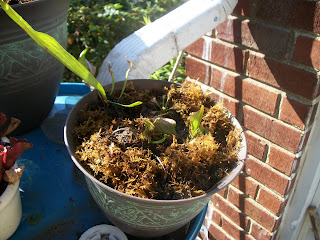Mike Lannom's Carnivorous Plants
The purpose of this blog......
The purpose of this blog is to educate the public on
how easy and fun it is to grow and care for
carnivorous plants.
how easy and fun it is to grow and care for
carnivorous plants.
Saturday, November 12, 2011
Wednesday, September 22, 2010
The Tennessee State Fair

This was an interesting Fair and I was able to show my plants.
It was ten days of fun and education. The Davidson County
Master Gardener Association displays an educational booth.
We did a lot of talking about plants and such. I enjoyed talking
about carnivorous plants. We set it up like a carnival sideshow
to draw people into our booth .
The agriculture building is next to the livestock barns
and it has a lot of insect activity. I got the opportunity
to tell folks how carnivorous plants emit pheromones
that attract these insects. The flies would hang out all around plants. Enjoy these photos of the plants during and after
the fair.
Tuesday, August 3, 2010
Corn worms and Carnivorous Plants

It has been a full two days I have discovered that some carnivorous plants
digest insects at different rates. Venus Flytraps when ingesting corn worms
will completely consume them in a 24 hour period. These plants eat one day
and open up to a empty shell the next. The only thing that is left is the
skull and skin of the worm. The flytraps do take longer if they are eating
insects with a harder shell. Pitcher Plants on the other hand eat slower
and will keep the body of the insect until just about everything dissolves.
Venus Flytraps can really put corn worms away and they do so completely.
The plant starts out slow and closes encasing its prey in the plants temporary
stomach where ingest occurs. Once inside this pouch the plant secretes its
digestive juices dissolving the insides of the insect. Below are some recent photos
of plants having dinner.
Wednesday, July 28, 2010

The photo below of the Venus Flytrap never gets old.
It is so amazing in that it and other carnivorous plants all produce flower high above
their trap mechanisms. They would never reproduce after their own kind.
The plants need to eat insects to live,but they also need them for pollination.
I wonder how evolutionist explain this. I like to think of it as Intelligent Design.
As I write I want to change gears and thank Ron West with Cascade Carnivores.
They have a great selection of tropical pitcherplants, Butterworts, and Sundews,
as well as other carnivorous plants. I order the native Intermedia Sundew and
received such an excellent specimen that when I ordered again I received such
a good product that I was able to divide it and get 100% success ratio. I will go
on record this may not happen for everyone, but it speaks volumes about the
service and product you get from Cascade Carnivores. Their website is
http://www.cascadecarnivores.com/ .
Wednesday, July 21, 2010
How Carnivorous plants produce seed
Here is a photo you might find interesting.
This Venus Flytrap projects its flowers high
above the trapping mechanism. This is true
for all carnivorous plants in that they would
not want to catch their pollinators and there
by rendering themselves extinct. If you look
closely you can see carnivorous Sundew
plants doing the same by setting flowers high
above their traps as well.
This Venus Flytrap projects its flowers high
above the trapping mechanism. This is true
for all carnivorous plants in that they would
not want to catch their pollinators and there
by rendering themselves extinct. If you look
closely you can see carnivorous Sundew
plants doing the same by setting flowers high
above their traps as well.
Wednesday, July 14, 2010
The Lazarus Project explained

The Lazarus Project is a container garden of carnivorous plants
that have appeared dead or are close to it. The plan was to remove
them from the condition they were in and place them in a new
container to see if they can be revived. It appears to have worked
note the new growth on the Venus Flytrap and Sarracenia (pitcher
plant).
Subscribe to:
Comments (Atom)
